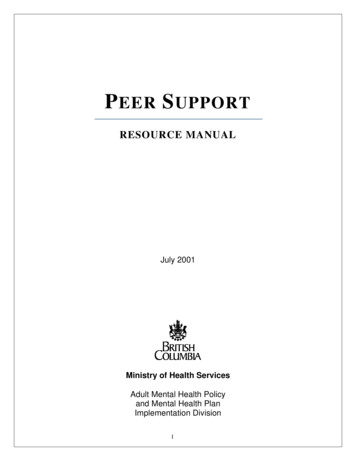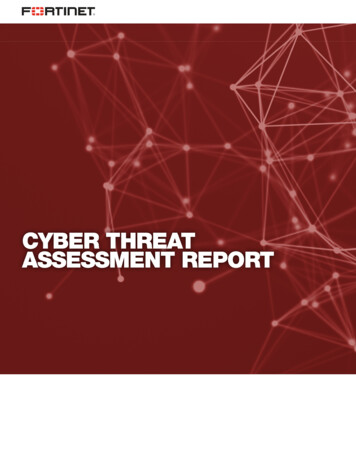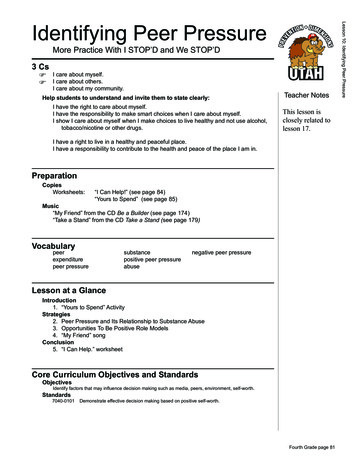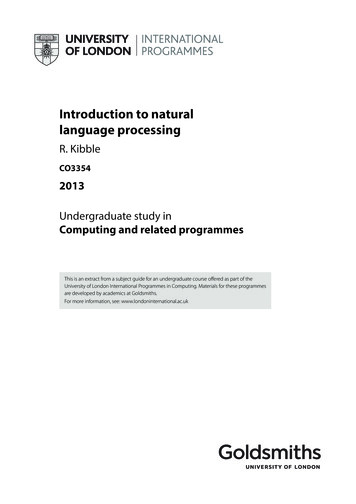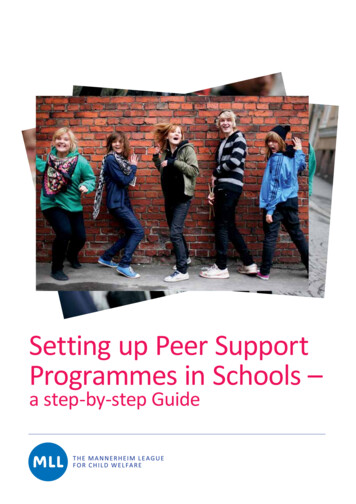
Transcription
Setting up Peer SupportProgrammes in Schools –a step-by-step Guide
PublisherMannerheimin Lastensuojeluliitto, 2011The Mannerheim League for Child WelfareFIN-00530 Helsinki, Finlandtel. 358 75 324 51mll@mll.fiLay-outTarja PetrellPhotographsRaisa Kyllikki Karjalainen (cover), Eva Persson (inside)
ContentsForeword s. 4PART 1: What is a peer support scheme? s. 5What is a peer support scheme? s. 6The aims of the scheme s. 6Values guiding the practice of peer support s. 8MLL s support for peer support programmes s. 10Peer support and participation s. 12The role of staff co-ordinator s. 13Peer supporters can make a difference s. 14PART 2: SETTING UP PEER SUPPORT SCHEMES s. 15Setting up peer support schemes s. 16Recruiting peer supporters s. 18Peer supporters in action s. 19PART 3: TRAINING MODELS s. 21Basic training s. 22Further training on bullying prevention s. 32Further training on feelings and emotional skills s. 38Bibliography s. 50Appendix s. 51Setting up Peer Support Programmes in Schools – a step-by-step Guide3
ForewordThe Mannerheim League for Child Welfareintroduced the peer student scheme for Finnishschools in 1972. The idea of having student peersupporters helping other students originated inthe United States and at first focused on substanceabuse education. The scheme has since expandedto cover a range of diverse practices. The keyobjectives of today’s peer support scheme arepromotion of students’ participation, reduction ofbullying and loneliness, as well as substance abuseeducation.The work of the Mannerheim League forChild Welfare is based on the United Nation’sConvention on the Rights of the Child, whichstresses the importance of involving children andyoung people in public decision-making. A peersupport scheme encourages young people totake responsibility and work independently. Peersupporters are ordinary students who volunteer towork for other young people and play an importantpart in developing a safe school ethos. The overallaim of the scheme is to ensure that no one is leftalone or bullied and that everyone can feel s/he is arespected member of the community.The Finnish peer support scheme has attractedinterest from abroad and led to inquiries fromour European partners. The purpose of this guideis to help schools and other organizations set upand device their own schemes. The guide hasbeen compiled from a variety of sources originallypublished in Finnish by the League. It has been editedby Kirsi Pihlaja and Satu Tallgren, the League’s YouthWork Coordinators, and translated by Pirkko Leinoand Timo Vilén.It is our hope that this guide will inspire you todevelop your own peer support schemes furtherand to encourage your students to contributeto their school and community. The activitiespresented in the guide have been tried and testedin several Finnish schools, and may not be directlyapplicable in other settings. However, we encouragethe reader to adapt them to local context. We lookforward to hearing about your experiences withpeer support schemes.Mannerheim League for Child WelfareMirjam Kalland, Secretary General4Setting up Peer Support Programmes in Schools – a step-by-step Guide
PART 1:What is a peer supportscheme?Setting up Peer Support Programmes in Schools – a step-by-step Guide5
What is a peer support scheme?A peer support scheme is based on the idea ofpeer support. The students are all each other’speers, as they are all about the same age, sharethe experience of being young and study in thesame school.In Finland, peer supporters are 8th- and 9thgraders in the upper grades of comprehensiveschool (aged 14–16 years ) instructing 7th-gradersaged 12–13 years. As many Finnish schools havebeen converted into comprehensive schools, theactivities and processes involved in a peer supportscheme not only address themselves to studentsin the upper grades, but also in the lower gradesof comprehensive school (aged 6–12).Conflicts, loneliness, exclusion and ostracisingare everyday occurrences in school life. Peersupport does not eliminate these problems butit helps prevent and combat them before theydevelop into a crisis.Peer supporters are ordinary students whowant to help others and contribute to the schoolcommunity on a voluntary basis. They receiveappropriate training, but there must always bean adult facilitator who retains responsibility forrunning the scheme and supervises them. Theservices of peer supporters include promotinggroup cohesion and positive group behaviour byrunning class discussions and organizing variousgames and activities that help students bond witheach other and work together. Peer supportersalso play an important part in preventing andcombating bullying. They also arrange a range ofvarious activities designed to promote a moresupportive atmosphere in schools, while at thesame learning in the activities and processesthemselves.The peer support scheme has establisheditself in Finland with a successful track record.The scope and range of peer support vary fromschool to school, and similar approaches havealso been initiated in many upper secondary andvocational schools as well as in the lower gradesof comprehensive school. Regardless of the levelof education, the underlying idea of all peersupport models is to have students helping eachother and guiding new students into the schoolenvironment. The scheme also involves the idea ofolder students providing positive role models andacting as “buddies” to the new intake students.6Setting up Peer Support Programmes in Schools – a step-by-step GuideStudents who become peer supporters gainlong-term social benefits such as increased selfesteem, and the development of interpersonalskills. The scheme aims at encouraging peersupporters as well as other students to exploretheir roles within the wider community. Peersupporters also help other students becomeaware of their responsibilities towards othersand encourage them to contribute to theirschools and the wider community. They helpsolving problems between disputing students,instil the values of tolerance into the schoolcommunity and support a positive schoolethos.The aims of the schemeThe aims of peer support scheme vary fromschool to school, reflecting the schools’ uniqueset of needs and circumstances. In addition,different actors involved in peer supportsystems are driven by their own motives. Whendesigning and setting up a scheme, it is worthdiscussing the various needs and aims so theactivities and processes related to the schemewill keep up the interest and drive of theparticipants.The Mannerheim League for Child Welfarehas defined general aims for peer supportscheme. The aims are based on Basic EducationAct (1998, 2 §), according to which the purposeof the basic education ”is to support pupils’growth into humanity and into ethicallyresponsible membership of society and toprovide them with knowledge and skills neededin life.” The aims are made up of four main aimsand several lower level aims.Promotion of considerate behaviour inschools refers to various means of advancingcooperative and friendly atmosphere inschools. Peer supporters’ task is to undertakeactivities that encourage collaboration andturn-taking among students, and that highlightthat every member of the school communityshould be valued and accepted for who s/he is.This contributes to students’ satisfaction withtheir school, and creates and atmosphere oftrust and safety, which in turn promotes andhelps learning.
The aims of the schemePromotion of considerate behaviour inschools– Safe learning environment– Co-operative and friendly atmosphere– Equality– Caring and supportive school ethos– Satisfaction with schoolPromotion of young people’s participationin schools– Participative culture– Young people’s influence anddemocratic education– Cooperation between school staff andstudentsProactive prevention of problems– Peer supporters as a bridge betweenschool staff and students– Preventing and reducing bullying– Preventing and reducing loneliness– Peer-led substance abuse educationPersonal growth– Learning– Social skills– Empathy– Responsibility– Active citizenshipPeer support programme also aims atpromoting young people’s participation. Thescheme is based on a belief that peer supportcan make a significant difference in schools.Compared to adults, peer supporters tend tohave greater credibility and approachabilityamong the students. When young people aretrusted and valued as an important resourcefor the school community, they learn aboutdemocracy and to think for themselves.In fact, peer support scheme provides acontext through which other students in schoolcan make their voice heard. In addition, thescheme encourages cooperation betweenadults and young people, thereby providingchances for everyone to engage for theircommunity. For example, if the school’s groundrules are established jointly by adults andyoung people, the rules are more likely to befollowed.Peer support aims at proactively preventingand tackling problems in schools. Peersupporters are more able to identify problemsassociated with bullying etc. and can act asa bridge between the student body and theschool staff. In addition, peer supporters setan example for other students in schools onwhen and how to discuss problems and referdistressed students to seek professional help.Peer support aims to prevent bullying andreduce loneliness. The underlying message ofthe programme is that every student shouldfeel safe and secure in school and that s/heshould be totally accepted and respected inthe school community regardless of his or hergender, race, religion, disability, and sexualorientation. Negative peer pressure involvedin issues related to alcohol, cigarettes, anddrugs is also worked through in peer-leddiscussions. Furthermore the assumption thatexperimentation with alcohol, cigarettes anddrugs is an integral part of adolescence is calledinto question.Peer support programme allows peersupporters and other students to learn andgrow as individuals. Different exercises,theme days, and everyday activities provideopportunities to practice communicationand social skills. Training sessions for peersupporters aim at equipping the participantswith skills they can put into practice not only intheir schools, but also in their everyday lives.The training of peer supporters is designedto increase their empathy and understandingtowards others, and to encourage them to getto know themselves and to examine their rolesas members of the larger school community.Through peer support scheme, young peoplelearn to act in a responsible manner and takeon challenges. Peer support also provides acontext within which other student can receiveattention from peer supporters. In addition,peer support sets an example of how youngpeople can engage and make their voice heardwithin the school community. The programmeis about activating everybody, not just thestudents concerned.Setting up Peer Support Programmes in Schools – a step-by-step Guide7
Values guiding the practiceof peer supportThe core values underpinning the MannerheimLeague for Child Welfare are as follows:appreciation of children and childhood, jointresponsibility, humanity, tolerance, equality, andjoy. The values of peer support scheme build onthese values.The valuesEqualityEquality means that everyone is valued as anindividual. Activities and processes involvedin peer support scheme are designed toimprove peer supporter’s ability to acceptthemselves as well as others as equal andunique individuals. By their own example, peersupporters also spread the idea of equalityamong the larger school community.VoluntarismPeer support scheme is founded on theprinciple of voluntarism. This is demonstratedby peer supporter’s willingness to takeresponsibility and to engage for the schoolcommunity.JoyWorking together is fun! Apart from peersupporters, all sections of the schoolcommunity can take pleasure in activities andprocesses involved in peer support scheme.ConfidentialityPeer supporters are obligated to maintainconfidentiality. However, difficult issues can beconfidentially discussed and worked throughwith other peer supporters, while peer8Setting up Peer Support Programmes in Schools – a step-by-step Guidesupporters are also encouraged to turn to theirsupervisors or other reliable adults for adviceand help.Youth and appreciation of youthYoung people are experts in their own livesand have the right to have a voice in issues thatdirectly affect them. Taking this as its startingpoint, peer support programme utilizesyoung people’s expertise in promoting andmaintaining a positive school atmosphere.Participation and empowermentof young peoplePeer support programme provides a chancefor young people to design, carry out, andassess activities related to the practice ofpeer support. It gives the young peopleconfidence that they can make a differenceand invites the larger school community toengage in constructive dialogue. In addition,peer supporters can act as a bridge betweenthe student body and the staff and ensurethat young people are listened to. Comparedto their adult partners, peer supporters maybe better placed to identify problems intheir schools and can pass on information toschool’s senior staff.
Core values, aims and resourcesof peer support schemePreventingand reducingbullyingSafelearningenvironmentCaring andsupportiveschool ethosAimsPromotionof consideratebehaviour inschoolsSatisfactionwith schoolPeer supportersas a bridgebetween schoolstaff andstudentsCo-operativeand ucationPreventingand vecultureCooperationbetweenschool staff andstudentsProactiveprevention ofproblemsLearningPersonalgrowthYoung people’sinfluence anddemocraticPromotion ofyoung people’s educationparticipationin schoolsActivecitizenshipSocial skillstrainingfinancial supportOtherresourcestime and material resourcesfull backing of all membersof the school communityResourcespeer supporterspeer support trainerheadteacherschool stafft arpwe a r t i cr m ipaen ti oto nafyou ndngpeoismconfidepounj oyemvo luayouth and appreciationof youtheqli t yntialit yother partnersValuespleReasons for setting upa peer support scheme:1. It allows the students to have a greater sayin the school Promotion of democracy3. It promotes the healthy growth of thestudents Increased well-being2. It contributes to young people’ssatisfaction with their school More activeparticipation in the community by thestudents4. Doing things together brings variety to theschool’s daily routine Opportunities fornon-formal learning5. It is FUN!Setting up Peer Support Programmes in Schools – a step-by-step Guide9
MLL’s support for peersupport programmesPeer support is the most important form ofthe Mannerheim League for Child Welfare’sinvolvement with young people and schools. Asfor today, approximately 90 % of the upper grades(7–9) of comprehensive school in Finland haveadopted peer support programmes.The nationwide network of peer supportincludes over 800 staff co-ordinators (recruitedmainly from the schools’ teaching staff),approximately 50 certified peer support trainers,and annually over 14 000 student peer supporters.Peer support programme is supported by the staffat the League’s central office and its 13 districtorganizations, as well as by hundreds of volunteersat League’s local associations.The League’s central office is responsible fordeveloping the peer support programme and forproviding information and training for staff coordinators and peer support trainers. Apart fromtraining, the central office also produces training10Setting up Peer Support Programmes in Schools – a step-by-step Guidematerials and manuals designed for co-ordinators,peer support trainers and peer supporters.Youth work co-ordinators at the League’s districtorganizations communicate with schools, and somedistricts even organize meetings for co-ordinatorsand peer supporters active in the region. Inaddition, district organizations communicateregularly with the people responsible for youthwork at the League’s local associations.Local associations provide practical support toschools in setting up and sustaining peer support.For example, this can involve contributing tothe costs of training of peer supporters (trainerfees, venues, catering etc.) Local associationsoccasionally also assist in the training of peersupporters or provide them with t-shirts, badges,or hooded jackets (imprinted with peer supportscheme’s logo) to improve their visibility. Inaddition, local associations sometimes offer grantsfor peer supporters.
Principles of good practicefor peer student programmesThe Mannerheim League for Child Welfare hasdeveloped a set of principles of good practiceto act as a basis for assessing and developingpeer support in schools.Activities and processes involved in a peersupport programme– demonstrate the fundamental values ofthe League’s peer student scheme– demonstrate the aims set by the League– are based on co-operation with theLeague’s district and local organizationsand other local actorsSchool staff and school management– staff co-ordinators are compensated fortheir work– the school allows adequate time andmaterial resources as well as adequatevenues for activities related to peersupport– peer support is written into schoolcurriculum– peer support is written into schoolstrategy– the division of labour and tasks betweenpeer supporters and student council isclear and known to everybody involved– the students and the school staff bothknow who their peer supporters are– peer support scheme has a full backing ofthe senior staff and the head teacher– the staff, students, and their parents/ carers are kept informed about theschool’s peer support schemeStaff co-ordinators– take part in training, meetings, andseminars organized by the MannerheimLeague for Child Welfare– take advantage of manuals and othermaterials produced by the League– join the League’s mailing list to receivetraining material and topical information– take responsibility for selecting andsupervising peer supporters– provide guidance and supervision to peersupporters on a regular basis– set up the aims for school’s peer supportactivities alongside with the peersupporters– act as intermediary between peersupporters and staff– provide feedback and keeps up themomentum for peer studentsStudent peer supporters– receive appropriate training in issuescentral to the practice of peer support– receive refresher or updating training asthe programme unfolds– take advantage of manuals and othermaterials produced by the League– organize morning assemblies and deliverpresentations for their ”buddy classes”– guide new students into the schoolenvironment and help them bond withtheir classmates– organize activities that promote positiveand supportive school ethos– are involved in proclamation andpromotion of School Peace during theschool year– combat bullying and facilitate socialinclusionSetting up Peer Support Programmes in Schools – a step-by-step Guide11
Peer support andparticipationPeer groups play a fundamental role in the livesand personal development of children and youngpeople. However, adults do not always fullyunderstand how important peer relationships arefor young people. Being accepted by one’s peersis essential, and young people often define socialexclusion as isolation from their classmates.Research has shown that peer-led approachesare an effective way of engaging young peopleand children. Young people feel more comfortablediscussing sensitive issues with their peers thanwith adults, and are in general more likely to seekhelp from other young people rather than fromparental figures. In addition, young people arekeen to learn from their peers, and often questionthe authoritarian approaches used by adults. Inshort, peers are better able to relate to their peersbecause of their age and common experiences –and that is why peer supporters have a very specialrole to play within the school community.In spite of this, many adults still think that youngpeople have little to contribute. There is, to besure, a widespread agreement that children andyoung people should be included in the decisionmaking process at levels appropriate to theircapacities. Nevertheless, when it comes to e.g.school activities, the adults are used to planningthem without consulting the students.Adults are responsible for ensuring that youngpeople are being involved through representationand participation. Genuine participation isdemocracy, and the best way to teach democracyto students is to incorporate the principles ofdemocracy into the school practices. Participationby young people should not only be encouraged,but actively sought out and welcomed as a valuableinput. And more than that, young people should12not be treated as objects, but rather as significantpartners whose participation benefits and enrichesthe whole community. Learning young people totake responsibility for themselves, other people intheir community, and the environment requires anatmosphere of trust and mutual appreciation. Thisoften calls for a change in the way we think aboutyoung people: Do we trust them? Do we listento them? Do we recognize their needs and do weshow that we appreciate them and what they do?In this guide participation is understood asyoung people having a voice and impact ondecisions that directly affect them. It means youngpeople setting their own goals, making decisions,and learning to take responsibility for theirdecisions.Setting up Peer Support Programmes in Schools – a step-by-step GuideEnabling young peoples’ participationdoes not mean:– straightforward transfer of power fromadults to young people;– adults giving up their share ofresponsibility;– prioritising young people’s views overeveryone else’s;– leaving young people without guidanceor support from adults.Participation does mean:– helping students behave in a responsibleand co-operative manner;– respecting different views and practicesand allowing discussion;– listening to young people’s ideas and,when feasible, implementing them;– learning and doing things together.
The role of staff co-ordinatorPeer support requires an adult co-ordinator. Oftenthey are staff members, but a school nurse or alocal youth worker can also take responsibility forrunning the scheme. Larger schools often havemore than one co-ordinator, and some schools alsohave a specific steering team with representativesfrom the staff and peer supporters.Although the scheme depends heavily on coordinator’s enthusiasm and commitment, theschool must allow adequate resources for peersupport to succeed. Co-ordinators must haveenough non-contact time for administration andsupervising the peer supporters, coupled withfinancial resources to cover e.g. materials and peersupporters’ training. Ideally co-ordinators shouldalso be trained in participatory methods and groupdynamics, especially if s/he is not familiar withthese approaches.Co-ordinator’s role is to facilitate peersupporters’ potential and to help them come upwith their own ideas, rather than control them.However, it is the adult supervisor who takes theresponsibility for running the scheme and decideson its aims together with the peer supporters.The co-ordinator also ensures that activities andprocesses involved in the scheme are adequatelyassessed and evaluated, and keeps up theenthusiasm for the participants.Co-ordinator’s personality plays a major part incontributing to the success of the scheme. Manyco-ordinators have told that their work has helpedthem see their student through new lenses andfrom an entirely different perspective. In addition,involvement in a peer support scheme providesan opportunity for co-ordinators to develop theirinstruction to better meet the needs of individualstudents. The relationship between a co-ordinatorand peer supporters is somewhat different to anormal teacher-student relationship. For youngpeople, the co-ordinator represents a reliableadult they can turn to for help and advice; anadult who is interested in their personal growth,gives positive feedback, and does not assess theirprogress numerically.To avoid misunderstandings, the co-ordinatorwill need to ensure that other members of thestaff are kept informed of peer supporters’meetings and other engagements. Another factorthat contributes to the scheme’s success andsustainability is that co-ordinators are not replacedevery year. This is something that must be kept inmind when introducing the scheme. In fact, someFinnish schools have co-ordinators who have beenactive for more than twenty years and still findtheir work important and stimulating.Working together prevents exclusionParticipation can only take place whenadults are sensitive to what young peoplesay and what they need. A co-ordinator mustbe patient enough to allow young peopleto come up with own ideas and define,plan and carry out activities – though it cansometimes be difficult not to push throughone’s own ideas.Watching young people grow anddevelop is a wonderful experience. The bestthing about processes that involve youngpeople is the genuine joy they get out ofthem. These activities can be enormouslyimportant for them, as they can involve newfriends and a boost for their confidence.Working together prevents exclusion andcan give a new direction for young people’slife.Young people have lots of new ideasand lots of energy. They must have properfacilities and other resources to put theirprojects into action. Involving youngpeople requires the support of our partnersand sponsors and an adult who bearsresponsibility for facilitating their activities.Tuula Lahti, teacher,peer support co-ordinatorSetting up Peer Support Programmes in Schools – a step-by-step Guide13
Peer supporterscan make a differencePeer supporters are volunteers who are willing toengage for other people and their community in apositive and constructive manner. Although peersupporters are not expected to demonstrate animpressive school record, they do need to have apositive attitude towards school and learning andan understanding of the school’s culture. In a way,peer supporters can be viewed as sorts of receiverspicking up weak and strong signals from theschool community. Peer supporters simply take aninterest in what is happening in their school. Theyact on the signals they receive and deal with a widerange of problems before they develop into a crisis.By promoting diversity and equality, peersupporters set an example to the entire schoolcommunity. Involvement in a peer supportprogramme allows students to become aware oftheir own prejudices, while at he same time helpingthem respect people with different cultures,beliefs, traditions, and languages. Although peersupporters do not have to be everyone’s bestfriends, they do have many of the qualities of agood friend such as honesty and reliability. Theyare easily accessible, willing to listen to otherstudents’ concerns and, when a referral shouldbe made, know where to seek more formal andprofessional help.Maintaining confidentiality is essential for thepractice of peer support and its appreciation.However, respecting confidentiality does notmean that confidential information may underany circumstances be disclosed: it means thatconfidential issues should never be told or repeatedto anyone outside the peer supporters’ group. Inaddition, peer supporters should be taught thatwith serious disclosures they are bound to referthe matter on to the co-ordinator or other seniormember of the staff.While various activities, such as theme days andcelebrations, play an important part in promotinga positive and supportive school ethos, they shouldnot be the main focus of the service: rather than onspecial occasions, peer support manifests itself inthe everyday workings of the school.14Setting up Peer Support Programmes in Schools – a step-by-step GuidePeer supporters sometimes become overenthusiastic and need to be reminded that they arenot responsible for eradicating all the problems intheir schools. As peer supporters often becomefriends with each other, there is also the risk thatthey begin to resemble an exclusive club. Shouldthis happen, the co-ordinator must be preparedto step in and bring the group back to its task. Insome cases, peer supporters can make themselvesguilty of bullying or ostracising. Clearly, a studentwho bullies others cannot be a peer supporter.The most important dutiesof a peer supporterHelping student bond with each otherCaring about other studentsBeing a “buddy”Being him or herselfInternational WeekAs peer students, we were involved in designing an International Week for our school.The idea was to introduce the students to internationality issues. Each day of the weekfocused on a different country, with a teamof peer supporters planning the content ofthe day. My team worked on Switzerland.In the morning of the SwitzerlandDay, we gave a short lecture on the rightsof young people in Switzerland over theschool’s PA system. We also had a quiz witha few easy questions on the country, its currency and languages, etc. At the end of theday, we hold a lottery to determine which ofthe students would be given the prize, Swisschocolate and cheese.Iida Vesterinen, peer supporter, aged 16Keuruu Comprehensive School
PART 2:Setting up peersupport schemesSetting up Peer Support Programmes in Schools – a step-by-step Guide15
Setting up peer support schemesIn many Finnish schools, the reasons for adoptingpeer support relate to bullying and efforts toreduce it by promoting a more caring school ethos.Other reasons include providing student a forumto express their views and simply vitalizing theschool’s everyday life. The initiative for setting up ascheme may come from the students, the staff, orthe parents/carers.Before designing and setting up the programme,the aims of the programme and commitment
What is a peer support scheme? s. 6 The aims of the scheme s. 6 Values guiding the practice of peer support s. 8 MLL s support for peer support programmes s. 10 Peer support and participation s. 12 The role of staff co-ordinator s. 13 Peer supporters can make a difference s. 14 PART 2: SETTING UP PEER SUPPORT SCHEMES s. 15

